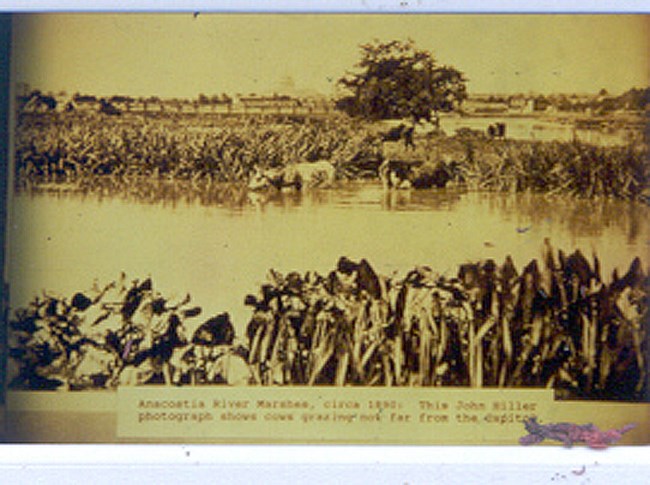
park library Field Study Section By visiting the park one can use weather monitoring equipment and work with a ranger to see first hand how the park might be affecting the weather, and explore possible outcomes for the future. One might find: -Plants and water mitigate warming from hard city surfaces - Pervious surfaces absorb rainwater reducing flooding - Park fields and wetlands are cleaning the water as the city uses more water for more uses - The basin of the park itself is a catch basin for floods and will become more important if sea levels rise as predicted over time - The living ground cover of the park may be trapping heat and pollutants, or slowing wind Finding the Anacostia Park’s Role: Learn about watersheds and tides: Equipment needed. The watershed map (link to the map and answer given on this page), photos ( links are included on the next page ), tide chart from http://www.saltwatertides.com/dynamic.dir/potomacsites.html and click on AnacostiaRiver. Learning standards number sense, data analysis: gather, organize, and analyze data, scientific inquiry, identify variables Time involved: an hour Skills used: Science methodology, ecology, data collection and organization, identifying factors of change Explanation: A watershed is the land that drains into a body of water such as a river. Try and map a watershed. It is land that drains into a single body of water. The Anacostia River is a watershed made of the watersheds of many streams. The Anacostia River itself is a part of the Potomac Watershed, which is a part of the Chesapeake Bay. Click here for a map students can use to trace the outermost source of streams that flow into the Anacostia River. From one of the heavy dots on the map, trace the outer tip of all the streams that drain into that river to connect to the dot on the other side of the Anacostia River. The answer is on the next page. These are PDF files that can be copied courtesy of Anacostia Watershed Society of Bladensburg, Maryland. Anacostia Park runs almost the length of the Anacostia River as it flows through Washington, DC. Throughout the watershed, the area is heavily developed with roads, businesses, and homes. Most of the original wetlands of the Anacostia River are now developed as businesses, and recreation areas. The park is a green space running through a very urban area. Does Anacostia Park, an area of wetlands, grass, and trees, have a role in the developing story of climate change? What is now Anacostia Park used to be wetlands where people grazed cattle, fished or hunted, and it flooded regularly. Wetlands is a general term applied to land that is flooded on a regular basis. In the photo to the right, the areas that have plants are the wetland, the area between is the Anacostia River. You may notice the Capitol dome in the background. The cattle making a path though the plants to drink are one of the causes of erosion in wetland areas. Soil washes down that path and begins filling in the river. Wetlands trap the soil and keep it on the dry land. The less broken a wetland is by paths or other breaks, the better the wetlands can work. Over time wetlands and river channels will change. It is sudden changes that cause the most damage. For more historical perspective of Anacostia Park and photos for practice on flooding and the role of the park click here. |
Last updated: May 31, 2019
